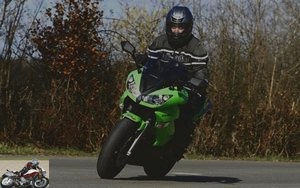Menus
- Test of the faired version of the Kawasaki ER6 ABS twin-cylinder
- Discovery
- In the saddle
- Contact
- City
- Highway
- Departmental
- Comfort
- Tires
- Brakes
- Convenient
- Consumption
- Accessories
- Conclusion
Test of the faired version of the Kawasaki ER6 ABS twin-cylinder
The Kawasaki ER6f is the streamlined version of Akashi’s ER6 twin-cylinder roadster originally presented in 2006 ("f" for fairing). While taking again the base of the new ER6n 2009, the ER6f undergoes a facelift in depth with a completely new line which gives it instantaneously more presence than the old model: goodbye the curves for a more angular fairing, a prominent double optic and enlarged, hexagonal mirrors… which give it a real "sport" or even sporty touch. Just a touch ?
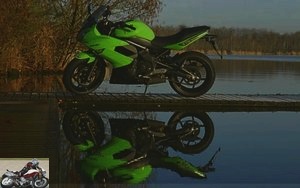
Discovery
Still a variation of the naked version, the ER-6f therefore shares the essentials with the latter: the frame, the engine and the handlebars. Suddenly, even the driving position is identical, straight and natural. Suddenly, the ER6f offers a sporty look but with roadster driving comfort for the wrists. On the other hand, the fairing puts a little more weight on the front and draws the head into the bubble. So, we modify the position ourselves a little to go more forward than with the N version.
Alongside the curves of the old 2006 model, the new ER6f is externally more aggressive, in particular by its dual front optics, the side covers incorporating the indicators, the tapered rear LED light, the aluminum passenger handles with rough angles and the hexagonal mirrors mounted on the fairing.
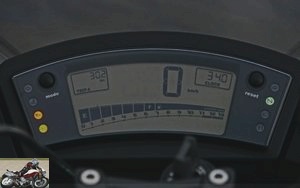
If the outside line changes, this also conditions a fully digital "GP" style speedometer, replacing the old all-analog speedometer which was already looking old when it was released. Especially the new meter now includes a fuel gauge.
The new instrument panel integrates in the same block, the bar tachometer occupying the entire width of the screen (bottom), overhung by the 3 digits of the speedometer. We note for the first time the ability to view partial trip (on the left) and clock (on the right). The counter is readable in use.

In terms of colors, the 2009 vintage is reduced to Kawa green, black and "royal" blue (plasma candy). All of this contributes to the strong rapprochement with the Ninja.
As we get closer, we can see an even more refined finish everywhere than the previous model..
In the saddle
Despite a saddle height of 790 mm, identical to the 2006 model, the feet touch the ground better than on the old model for the 1.70m pilot, thanks to a lower and narrower saddle already fitted to the 2009 ER6n. In addition, the new ER6f still offers an even narrower and lower saddle as an option..
Contact
The counter resets. The sound of the pot is almost rough and even deep, while the bike has only 1,000 km…. especially when you know from experience that the sound of the ER6 becomes more hoarse with the kilometers.
The visibility of the new mirrors is better than the old model. We only see a third of the elbows there compared to more than half previously.
The ER6f seems almost calm under 4,000 rpm, even if it accepts to wind up on the torque from 2,000 rpm. Suddenly, it is even possible to drive quietly in the last gear at 45 km / h !
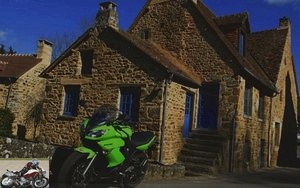
As for the vibrations, they have practically disappeared … thanks to everything that was mounted on silent-block: frame at several points, footrests, passenger handles … We still feel a little that it is a level byclinder vibrations … but that’s also the difference with a four-cylinder !
City
Lightweight despite being overweight in front of the ER6n, the ER6f weaves its way through traffic with ease. Turning around is effortless in a lane, thanks to a turning radius of 3.2 meters. The featherweight, unchanged of 200 kilos all full is also for a lot.
If the engine knocks below 1,800 rpm, it winds quietly from 2,000 rpm in 6th gear up to 5,000 rpm, before soaring into the revs. The ER6f works well in town in 3rd and 4th gear, turning around 5,000 rpm.
Highway
The ER6f is happy to take to the motorway at over 5,000 rpm, spinning slowly at 105 km / h. It is at this speed that the engine really takes its revs and therefore quickly revs up to reach 125 km / h at 6,000 rpm (at 5,000 rpm in the red zone) with an elastic effect at this speed to then propel it an additional 25 km / h every 1,000 rpm … up to the 11,000 rpm in the red zone.
The fairing plays its full role here to protect its pilot very effectively. There, where the ER6n keeps releasing the handle at around 150 km / h, the ER-6f prompts to open again and again. The limit is no longer the resistance of the necks or the wind pressure but the ability of the pilot to exceed 200 km / h (and his willingness to lose his points on his license).
Unperturbed, even at very high speed, the ER6f does not take the effect of the wind and remains stable despite its featherweight. The contrast is significant compared to the old model which did not encourage confidence at high speeds. Here, on the contrary, it is the confidence that is brought…
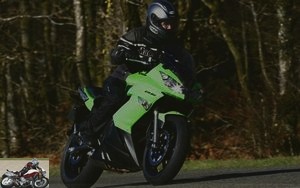
Departmental
Like its naked sister, the ER6f finds its favorite playground on the small roads. Frank acceleration above 5,000 rpm, and even more above 6,000 rpm, the twin cylinder allows you to chain the virolos at a sustained pace over the range of use from 5,000 rpm to 10,000 rpm , rhythm at which the engine howls with pleasure…. like the pilot. In this game, the reports readily oscillate between 3rd and 4th. And at the end of the day, he agrees to wind in 6th under 3,000 rpm.
The cycle part is up to what the look lets hope; really easy to put on the angle, the ER-6f lets itself dictate its driving to the good will of the pilot or the apprentice pilot so easy it is. In fact, she bends to all whims without batting an eyelid, easily going where the eye is and without having to force her..
The small displacement makes it possible to open big throttle with a free kick without side reactions. In fact, the limits of the motorcycle will only be found by heavy riders who are used to maximum sporting displacements..
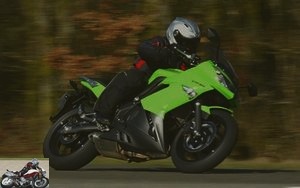
Comfort
The ER6f is quite comfortable, the natural position helping. If the suspensions are firm, the ER6f no longer jumps on pavement defects like the previous vintage.
On the rider side, the saddle is rather pleasant, especially as it does not interfere with changes of position. On the passenger side, the handles are now mounted on silent-block and are therefore vibration-free.
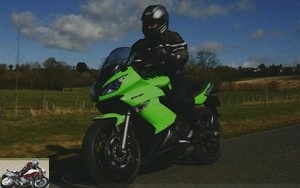
Tires
The Bridgestone BT020 have made way for the BT021 for the 2009 vintage and do not suffer from any reproach.
Brakes
The ER6f brakes hard, gradually while providing a good feeling. Without ABS, the rear blocks quite easily. With ABS, pressing hard on the rear and / or front brake does not trigger the ABS. You really have to start working out, which the ER6f prompts you to do, and grab the right grip and smash the rear brake to feel the ABS kick in, especially at the rear. Everything is easily dosed, especially for the beginner.
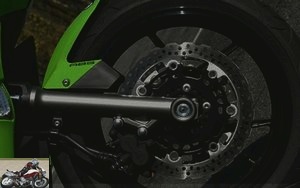
Convenient
There is a little more room under the saddle than on the old model, but not enough to fit more than a U.
There are always under the saddle, the tie-down hooks as well as the metal wires for the helmet.
The mirrors no longer vibrate! And suddenly, their usefulness and visibility has significantly increased.
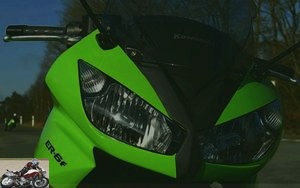
Consumption
Consumption remains identical to the previous vintage and a little below the Naked version…. overall just under 5 liters per hundred, except in the case of muscular driving where consumption can then go up to 6 liters. If the shape of the tank has been changed, the capacity remains the same at 15.5 liters, and therefore allows a range of about 300 km, the ER6f being one of the most sober motorcycles on the market in this displacement, even the more sober of all the displacements above 500 cm3. And then, the 2009 vintage finally gained a fuel gauge – more precise – which loses a stick approximately every 50 km.
Accessories
Kawasaki offers with this 2009 vintage:
- a tank guard
- a 30-liter top-case in the colors of the motorcycle
- a rear seat cover
Conclusion
The ER6f drives almost with your eyes closed … as easily as its sister Naked ER6n but with the added protection, excellent. It is therefore ideal for beginners who dream of a sports car without being able to afford it, both in terms of motorcycle price and insurance. It will delight those who want to go far and who are tired of the N versions due to their lack of protection..
With a sportier look "more Ninja" than the previous model and ease of handling accompanied by excellent driving pleasure, the 2009 ER6f should conquer more than the previous version. Only its price, which rose very slightly to 6,599 euros (7,199 euros for ABS) could smooth out its promised success, especially since the previous vintage is experiencing exceptional promotions..
In short, the ER6f 2009 is a real evolution, successful, having corrected the rare defects of the previous vintage..
Strong points
- dynamic qualities
- protective fairing
- autonomy
Weak points
- I’m looking for a central stand maybe ?
Competitors: Honda CBF 500, Honda CBF 600, Suzuki SV 650S, Suzuki 650 GSX-F, Yamaha 600 XJ6 Diversion
User reactions and testimonials on the
Kawasaki ER6f motorcycle guide (old model)
Kawasaki ER6f tech. Sheet
Related articles
-
2009 Kawasaki ER-6n motorcycle test
3-day twin-cylinder roadster test The Kawasaki ER6n is Akashi’s twin-cylinder roadster initially introduced in 2005, which has achieved unprecedented…
-
2012 Kawasaki ER-6f motorcycle test
Swiss army knife first price While the ER-6n has been a historic bestseller in the Kawasaki lineup since its debut in 2006, its streamlined “f” version…
-
Comparative motorcycle test Kawasaki Ninja 650 A2 and full
Daily trial for 15 days of both versions 649 cc, 68 hp – 47.5 hp in A2 – for 193 kilos Who remembers the ER-6, the model unveiled in 2005 and since…
-
Kawasaki ER-6 N motorcycle test
A very stylish and punchy little urban The city of Mozart sounded for three days of a superb symphony in major exhaust. Orchestrated by Kawasaki making…
-
Kawasaki Versys 650 motorcycle test
Twin-cylinder 649 cc, 69 hp, 210 kilos, A2 version, euro5 ready Daily test 2006, the year of the successive revivals of Kawasaki on segments where we…
-
Roadster with Sugomi sauce or decarenated sports car A2 licenses have the choice between large bridles, sometimes very badly bridled, and smaller ones,…
-
2012 Kawasaki ER-6n motorcycle test
New test: Kawasaki ER 6N: Sparkling with mischief ! Appeared in 2006 and restyled in 2009, the ER6 N gets a new facelift that makes it even sexier,…
-
Biker test: David B. At first look the BMW R1150R serves a design combining class and sobriety. The lines are more worked than on the old R1100R and the…
-
2007 Kawasaki Z1000 motorcycle test
Five-day test of the 2007 vintage roadster The Kawasaki Z1000 released in 2003 was well received but mixed: a look of hell but an engine considered like…
-
Kawasaki Z 750 motorcycle test
Cure of youth After a big success and more than 62,000 models sold, the Kawasaki Z750 evolves only 3 years later its output: engine, chassis and design….
